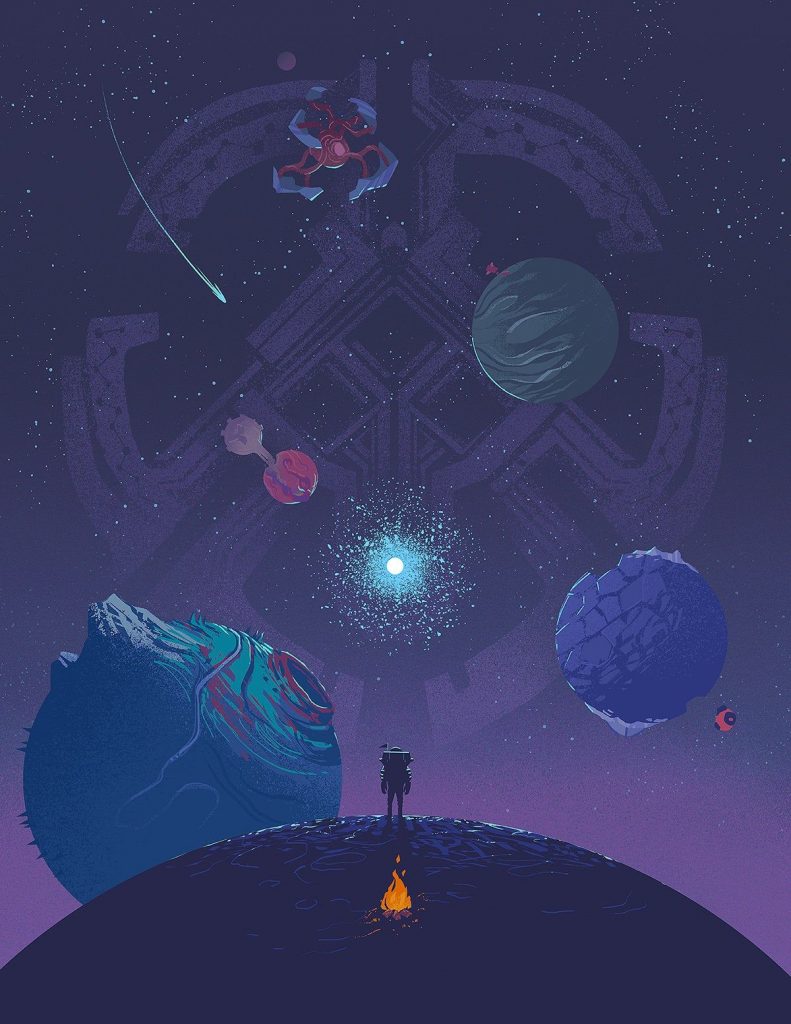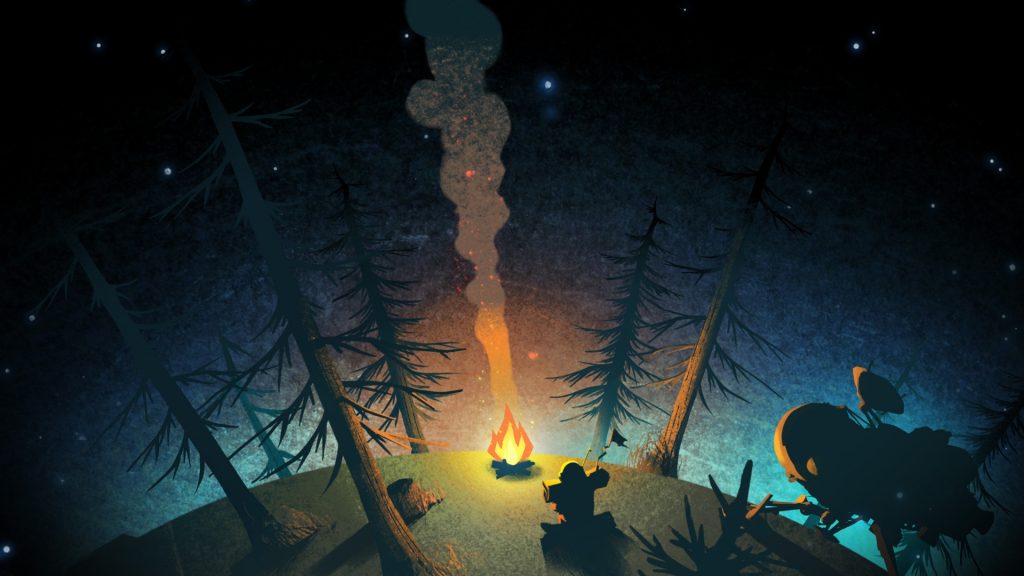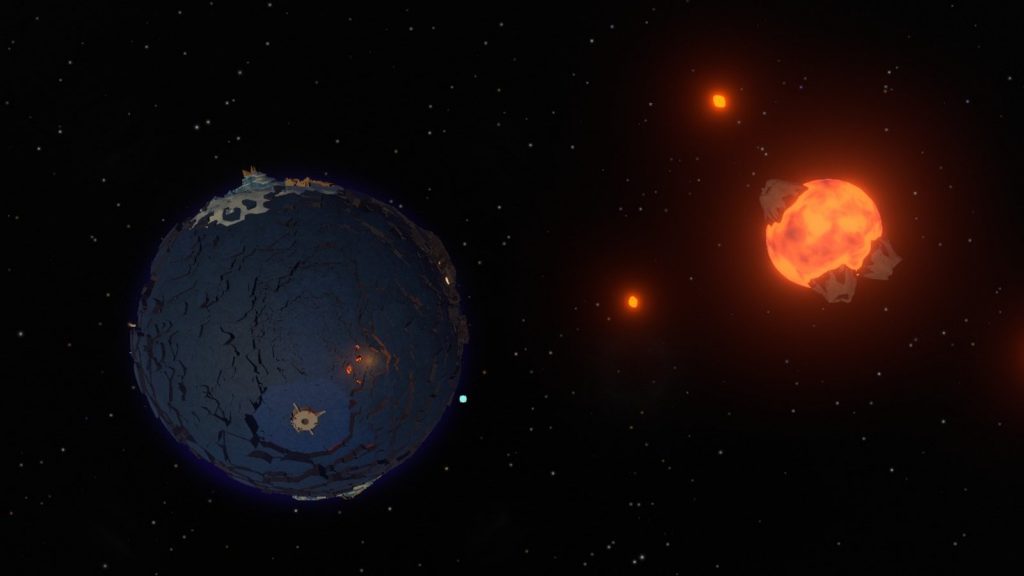Outer Wilds Review
What happens when you create a game that has a beautiful, open-ended solar system with no hand holding and nothing to push you along other than your own burning curiosity? You get the exploration adventure masterpiece that is Outer Wilds.
Note: this is a spoiler-free review.
You awaken, gasping and opening your four eyes to the sight of a large green planet in orbit high above you. Something explodes near the giant planet. You’re then tasked with making your way to the observatory high above the small town and stopping by a few places on the way.

Normally it wouldn’t garner much attention but the “tutorial area” of Outer Wilds is a brilliantly-designed area, containing every little nugget of knowledge that a player will need to take with them for solving puzzles, navigating around the star system and learning what to do with certain things. Between the tutorial to learn how to fly the model space ship, to navigating in zero-g, to the fascinating museum beneath the observatory, you’ll learn everything you need to know – there’s no unlocking more gadgets that will later allow you to get to new places, or a better space ship to travel to a different place. Alongside learning all these important gameplay elements the player will no doubt be enraptured in some of the more interesting displays in the museum. Why is there a scary fish that apparently came from a different planet? What is this creepy, moving shard-rock? With it, the first seeds for the story are planted, helping the player to form, in their mind, the first “quests.”
I say that in quotes because there is really no official quests or missions or anything of the sort, at least in the traditional sense. The normal “hand-holding” of walking a player through a very rigid questline is not present in Outer Wilds. Something I’ve touched upon in my Morrowind Review with how very boring and linear quests have gotten in more modern RPG games, this game presents you with clues, threads of a story, and it is left to you on which thread you follow.
At the start you’re presented with a few different threads to follow but you’re not even forced to follow any one. Right before you’re cleared to launch to effectively leave the tutorial area for the first time, Hornfels, the head astronomer asks you what you’d want to do first, giving you a few options like “Start with something small” or “meet up with other travelers (astronauts)” which helps point you to things you could do. But never does it do anything more than give you a thread of where to start.
After this its up to you! Each thread will take you in a different direction, but you don’t even have to be following a thread. You could just go fly to which ever planet looks coolest, or something odd caught your eye and wanted to check that out. You might discover something critical to the story, which will add another thread to follow, it might not.
These metaphorical threads are all kept track of in a web of clues that the player references and adds to within their ship’s computer. Right away the player is presented with a slew of questions that any curious space explorer would want to answer- what was that we saw blow up above us at the start? Why are those two planets orbiting so close? What’s with this white star over here? What are these ruins and who made them? Where did these people go? Following these threads allows the player to weave together the web of the story, while unraveling the mysteries of what’s going on and why there are some odd things happening within the Heathian’s star system.
Gameplay – 20/20
Outer Wilds features no combat and no fancy progression system, no shiny cosmetics or upgradable tools, nothing like that. Instead, it relies heavily on interesting mechanics and features of the planets and things a player might come across.
The core gameplay mechanic is centered on the game’s 22-minute cycle – where the sun explodes, going supernova and destroying everything before resetting back to the start, with you at the launch tower ready to explore. Note: I briefly considered not including this little nugget of info in the review… It’s a fun aspect to learn on your first time but it is integral to the game and the review of it. Not to mention I think the game itself explains it on Steam.

The gameplay loop involves using the time as wisely as possible before being reset, whether that means getting as fast as you can to a hard-to-reach location and unlock the next series of clues before the sun explodes, or utilizing time in just the correct way to unlock a puzzle.
Of course I don’t want to ruin any of the amazing puzzles, or the incredible story, but the elements within the tutorial area, especially the museum aid the player in how to unlock some of the challenges he or she may face.
So how can a game with no quests or obviously apparently storyline really work? I’ll be the first to admit it won’t cater to every gamer- the player must naturally be curious and adventurous and ask the questions that will lead to unlocking the mysteries. In many aspects it reminds me of Myst – a nonlinear adventure where you learn backstories and unravel the truth of what’s going on while solving puzzles.
Coupled with so many interesting locations and tasks, the player is eager to go to a number of locations. When I played there was always a laundry list of things I wanted to do and with each cycle I could only pick one or two. Think about it- it is incredible how, despite the game having absolutely no task list or quest system, I have a huge pile of things to do. I’m reminded of Factorio in its very ironic “always something to do” way (review coming soon!) – whose open-endedness is similar in that regard.

Graphics & Sound – 19/20
I’ll start first with the sound- first and foremost the soundtrack. What an epic and incredibly memorable soundtrack it is. Most of the tracks are linked to a location or doing something (like flying through space) but there are several great tracks, especially the menu and main themes that will leave you whistling it for hours after playing.
Along with music itself, the ambience is perfect, setting the tone for each of the mysterious locations. I found the hair raising on my neck in some cases, linked with unlocking more clues to the story. All really well done to keep you focused in on the beautiful world of Outer Wilds.
And beautiful it is – some of the scenes that you encounter across your travels are nothing short of breathtaking thanks in part to the odd scale of the solar system within the game. Planets are much smaller and distances are shorter making for many interesting panoramas and vistas. In a behind the scenes I recall that the game designers had a tough task of making important points on these planets visually interesting to convey that it is an important place to visit, as opposed to just “empty space” and this is done very well. While traveling around in your ship, there are many places you fly near and you can spot landmarks that you will no doubt wish to go check out.
Visual cues and scale are an important theme that help guide the player along. The sun, planets, areas and more all help to peel away the hidden layers of the story.
In the end, despite what is usually a vast emptiness of space, its so rare that the player would ever feel that way and instead is always greeted with a gorgeous view of a sunrise or sunset on a planet or an eclipse. So many things that really add to the incredible views.
Controls & UI – 14/15
Flying the ship came pretty natural to me, where I’ve played several games with zero-g / newtonian physics. It certainly was not easy to come to grips with the size of everything (the ship itself included) and landing is not the easiest. The controls beyond that are very basic, which is a good thing in keeping it simple and uncomplicated. Also worth mentioning is the helpful visual cues the player has while flying, especially when it comes to thruster direction and strength.
The UI is great and really shines when it comes to how the story (and your found clues) are presented. You can view this by planet / moon (where a given clue was found) or by a vast, interconnected web of clues that slowly stitch together the entire backstory of what’s going on. Each thread that I originally mentioned gets its own node in the web to start from, with an icon reminding you that there’s something to explore or learn. If it interests you, you can investigate it and after, you learn of other connected nodes leading you possibly in separate directions for more clues. Slowly more of the web will be revealed as the player works through the game.
Replayability – 10/15
As one would expect from a very story-driven and puzzle-driven game, the replayability is pretty low. After the mysteries of the game are solved, there really isn’t anything to do. There is definitely value in revisiting this game again down the line, but aside from that there’s not much replayability. Keeping in mind that that is the nature of the beast, I don’t hit the score too hard there.
Given how the story is told, the rich history of the world and the creatures within (you are a Hearthian, a four-eyed alien that doesn’t have a sex) there’s a lot to love. The places and scenes really do a great job keeping you in the game, alongside how the story is told.

I docked points for what I believe is probably the largest letdown in the game: NPC interaction. It’s not terrible, and certainly not a major focus point of the game, but more could be done in terms of reactionary dialog to keep it interesting, or giving you more reasons to talk to NPCs more often. At least a couple NPCs, after you talk to them, there’s zero reason to talk to them again. To contrast, one NPC in particular has interesting dialog choices based on the state of the sun (how close it is to exploding) and engages in some interesting discourse. I’d like to have seen a bit more of that to make the NPCs seem a little less static and robotic.
Challenge Level – 9/10
The game has some incredible puzzles that force you to really put on the thinking cap. Some just don’t seem solvable and so you leave and learn some more things about the universe and come back to it later and realize there was something you didn’t know you could do before unlocking the puzzle.

Sometimes it felt downright frustrating to want to unlock something and you just couldn’t figure out why. Persistent gamers will be rewarded so long as their patience does not run out. Otherwise it’s always a great idea to move on and return another time later, as there’s plenty more to explore and learn.
Overall the game felt very challenging and because of that, felt extremely rewarding to finally solve certain puzzles as the pieces clicked into place, on why I couldn’t open a door or get through to a certain area. And by the end of the game, you felt great on having solved the mysteries and learning what happened.
Mods & Modability – 5/10
A big ding here, but not unexpected. It is slightly unfair to rate this game based on its modability but I can’t bring myself to omit it from the score as it is, as I’ve established, an integral part of any great game. It breathes life into older games and keeps people playing the same game long beyond what might be expected. As I said though, it’s a bit unfair so I’m only deducting 5 points, despite the availability of mods being almost nonexistent.
OVERALL SCORE – 85
Outer Wilds is a masterpiece I didn’t see coming – I did not expect this game to be as good as it was. I had seen a little gameplay and a glowing review, but I had no idea this would fast become one of my top 10 games of all time.
The game is just so unique, while not completely new in most aspects, it is an amazing diamond in the rough at very little cost. The story is enthralling and even more importantly keeps you engaged with it, rather than mindlessly checking off boxes in a quest log.
I couldn’t recommend it more- don’t watch gameplay, don’t spoil it, just dive into the game and get lost. Enjoy the ride.



















